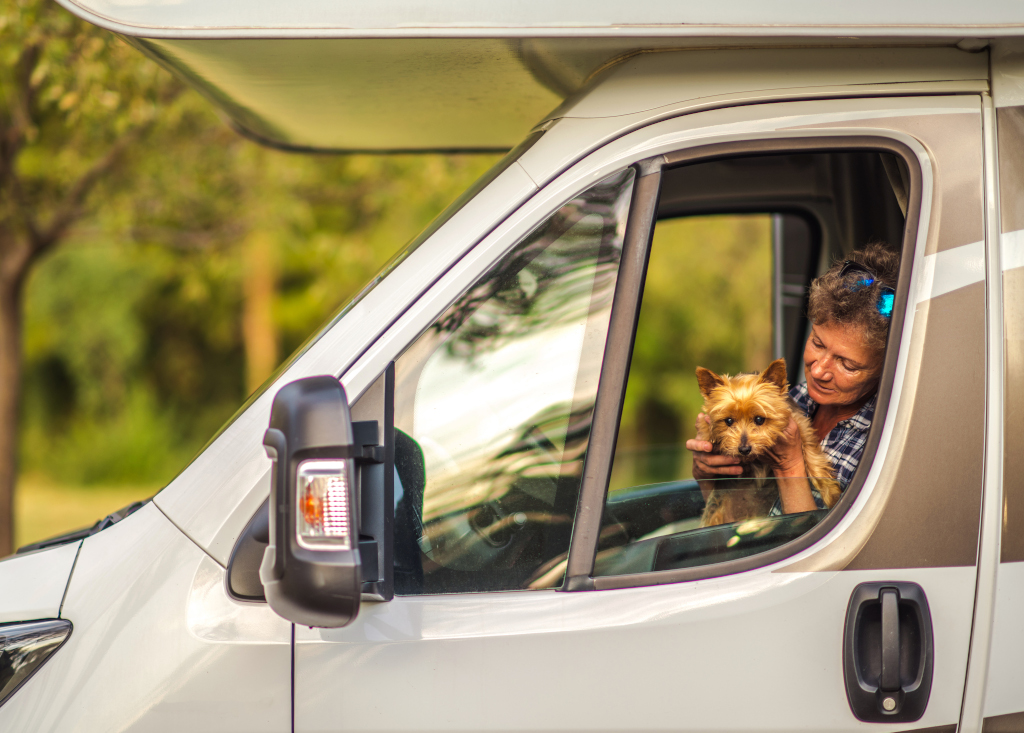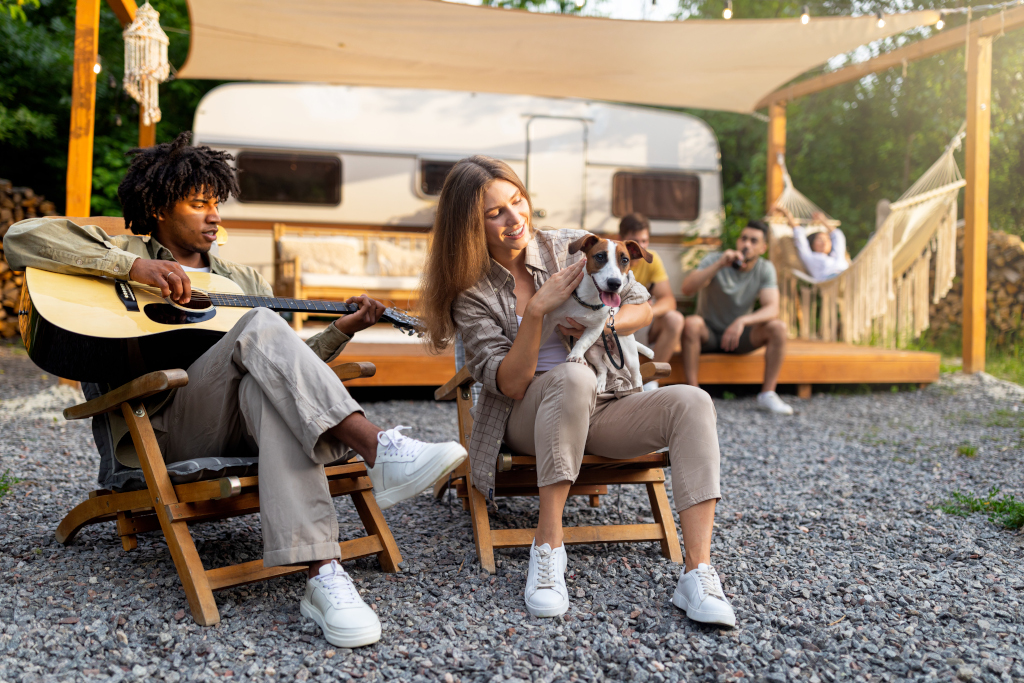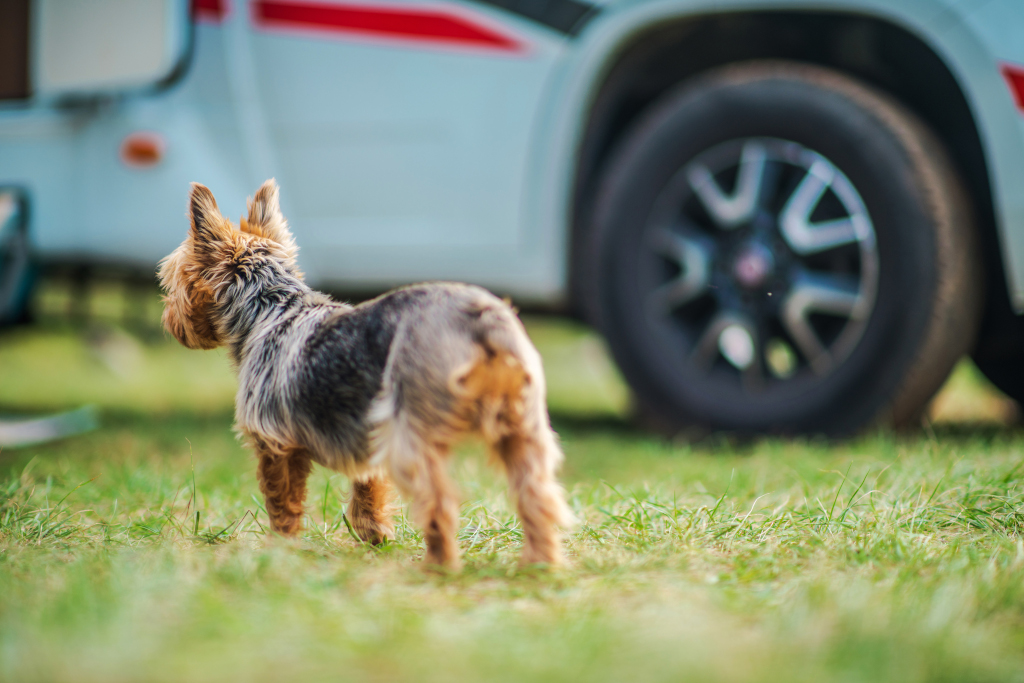RV camping is very popular these days. Many families choose this form of getaway over traditional camping because it allows them to connect with nature just as much as they want while giving them the ability to enjoy the comfort of home.
However, if you’re anything like me who has at least one furball in the family and plan to bring them along with you on your next road trip, then I’m sure you are worried about their safety and comfort too!
Well, join the club. Worrying over my dog’s welfare is always at the top of my mind whenever we go for an extended RV camping trip.
But truth be told, camping with dogs does not have to be a drag if certain precautions are taken care of, and proper preparations are made beforehand.
In this blog post, I’ll share everything you need to know about RV camping with dogs. So all RV camping enthusiasts out there, including yourself, can have a successful RV trip with your furry family members.
1. Get Your Dog Used to Travel in an RV

Many dogs can get overwhelmed, become anxious, or develop motion sickness while riding in an RV, especially if it’s their first time.
So before hitting the road with your dog, the first thing you should do is accustom them to travel in an RV and get them familiarized with the sound and motion of a vehicle.
Make sure to start by taking your dog out for short drives around the neighborhood or take them to places like your nearby vet, pet store, etc., before taking them on longer trips.
2. Create a Comfortable Spot in the RV for Your Dog
You’ll also need to create a comfortable spot for your dog in the RV. It can be a corner or a portion of the floor that’s big enough for them to lie down and turn around comfortably.
This spot will serve as your dog’s personal space, a place where they can unwind and relax. Meaning, you’ll have to place their bed and blanket there, so there’s something soft for them to lay on. Also, put their favorite toys there as well to make them feel at home.
If your dog does get travel anxiety, consider using a travel crate to help them feel safe and secure. Ensure it is large enough for your fido and properly secured so it doesn’t move around while on the road. Otherwise, you can also consider using calming collars for dogs that release calming pheromones to keep your dog relaxed during travel.
Read More: 8 Ultimate Safety Tips for Driving With Your Dog!
3. Invest in a Temperature Monitor Unit
There are times where you may need to leave your dog in the RV by themselves, so it’s best to invest in a temperature sensor, especially in summer, winter, or during extreme weather conditions and with no one around to keep them company.
These temperature monitoring units are specifically designed for traveling pets’ safety, which allows you to check the temperature and humidity levels in real-time. They will also send you alerts if it falls below or rises above safe levels for your dog.
What that means for you is you’ll always know if your dog is safe and comfortable, even when you’re away from the RV.
4. Make Sure the Campground is Dog-Friendly

Just as you would never bring your pet on a camping trip without first making sure that they are welcome in the place you are going, you need to check whether or not the campground is pet-friendly. Do not just pack up your things and head out.
Spend some time online to look for dog-friendly RV camping destinations just so that you won’t be turned away at the entrance. And always call ahead or check online for rules and regulations concerning pets.
5. Visit Your Vet Before the Trip
Your furry friend should be in top health before you hit the road. So, take them to the vet for a checkup before embarking on your trip so you can all enjoy yourselves when you get there.
You would also want to make sure all your dog’s vaccinations are up to date and ask for a rabies vaccination certificate as well as your fido’s health record. This way, if your furkid does get sick while on the road, there’s a copy of their health history you can show to your new vets.
And finally, ask for recommendations on any medications your canine might need, such as pain relievers or over-the-counter motion sickness medicine, and find out when and how much you should give your pup before leaving.
6. Get Your Dog a Microchip, Pet GPS Tracker, and ID Tags
If your dog ever slips away or is separated from you during travel, having them microchipped can be a lifesaver! In fact, you must have them implanted with a microchip before venturing out on any kind of adventure or road trip with them to ensure that you can be contacted when they get lost.
It’s also good practice to keep ID tags on your dog with your cell phone number written down so if someone finds your pup, the information is readily available for them to call you.
However, keep in mind there’s still a possibility that you won’t be able to reunite with your canine even if they have proper identification on them. Why? Simple. No one will contact you if your dog isn’t found.
That’s why it never hurts to get a pet GPS tracker, too! These devices allow you to track your fido’s whereabouts 24/7, and you’ll always be able to see where they are and have them back in no time, giving you peace of mind and no more panicking for hours on end wondering where your pup went off to.
7. Pack for Your Dog
Of course, as with all camping trips, you’ll need to pack for your dog as well. Be sure to pack their food, bowls, leash, toys, and any medications they might need during your RV vacation.
Ensure to bring enough water and never give your pup untreated tap water because it could contain harmful bacteria or chemicals that may make them sick. So, bring filtered water instead.
And if you plan to take your furry friend on a month-long RV vacation, don’t forget to bring grooming supplies, for instance, dog shampoo, conditioner, paw washers for cleaning up their dirty paws after walks or playing outside in muddy areas, and brush for combing out tangles and mats.
Also, remember to bring along your dog’s first aid kit just in case your pooch gets injured while out on your road trip. It doesn’t have to be anything fancy. A basic one will do the trick. Things that you’ll need include saline eyewash, disinfectant liquid, gauze pads or bandages, Benadryl (Antihistamine), tick removal tools, and disposable gloves.
Read More: Gear Your Dog Needs for Camping
8. Provide Your Dog With Plenty of Exercises

You do not want to leave your dog cooped up in the RV for hours on end throughout the day with nothing to do. Not only will this make them stir-crazy, but they might start to get into things and wreak havoc.
So, be sure to take your dog out for a good amount of walks, hikes, or runs around the campsite with you every morning or evening before you start or end your day. This will help keep your furry friend happy and healthy!
Read More: How to Keep Your Dog From Destroying Things
9. Keep an Eye Out for Wildlife
Needless to say, you need to keep an eye out for wildlife when your dog is running and playing outside your RV or camping tent.
This is especially important when you’re camping in an area known for having mountain lions, coyotes, bears (black and grizzlies), moose, bison, etc. These wild animals are dangerous and could easily hurt your pup if they felt threatened.
So, be aware of your surroundings and keep your pup close to you when in wooded areas.
Read More: What to Do When Encounter a Bear While Camping & Hiking With Your Dog
10. Have an Emergency Plan Ready & Know Where the Local Vets Are
No matter where you go, having an emergency plan is always a good idea. Consider all possible scenarios that may occur and be ready for anything.
Ask yourself questions like “What should I do if my dog gets bitten by a snake?” or “What is the number of the nearest 24-hour emergency vet clinic in the area around our campsite?”.
The more time you spend planning out what to do in case your dog falls ill or sustains an injury while on your trip, the easier it’ll be to act quickly when these situations come up. You’ll also know who exactly you can call and where you need to go, which means no more panicking and worrying about what to do next.
11. Be a Good Neighbor
When you’re at a campground or RV park, never forget to be a good neighbor. Always clean up after your canine and respect your camping neighbors who may not want to interact with dogs that have been walking around off-leash all day long or chasing other people’s cats.
Speaking of being a good neighbor, keeping your dog’s barking and howling to a minimum is also crucial. Remember that you’re sharing the space with everyone else in the area, so if your pup is being too loud or disruptive, then others may complain or confront you about it.
To ensure that doesn’t happen, you can either take your pup out for walks to tire them out, train them that barking is only allowed in certain situations, or give them toys to keep their minds occupied when you’re around. If all else fails, consider using an anti-barking device that emits a high-pitched sound that only dogs can hear to help reduce or stop nuisance barking.
This way, everyone will be happy and have a good experience while on their trip!
Read More:
Conclusion
While RVing with your furry friend is fun, it does take some planning ahead before you head out on that road trip with them by your side.
And with the right steps and precautions taken beforehand, you can rest easy knowing that your furry friend is in good hands and having a great time while you explore the country together.
Have a great time camping! Stay safe!
